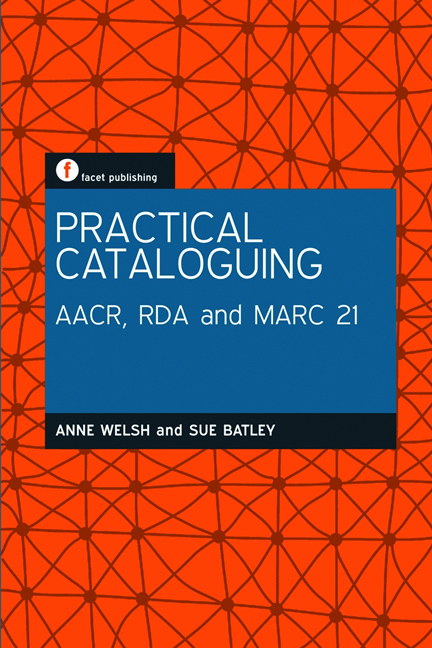Book contents
- Frontmatter
- Dedication
- Contents
- Acknowledgements
- Preface
- 1 Catalogues and cataloguing standards
- 2 The FRBRization of the catalogue
- 3 Bibliographic elements
- 4 Access points and headings
- 5 RDA: resource description and access
- 6 AACR and RDA
- 7 MARC 21
- 8 Practical cataloguing: bringing it all together
- 9 The birth of RDA and the death of MARC?
- 10 Examples
- References
- Index
4 - Access points and headings
Published online by Cambridge University Press: 08 June 2018
- Frontmatter
- Dedication
- Contents
- Acknowledgements
- Preface
- 1 Catalogues and cataloguing standards
- 2 The FRBRization of the catalogue
- 3 Bibliographic elements
- 4 Access points and headings
- 5 RDA: resource description and access
- 6 AACR and RDA
- 7 MARC 21
- 8 Practical cataloguing: bringing it all together
- 9 The birth of RDA and the death of MARC?
- 10 Examples
- References
- Index
Summary
What are access points and why do we need them?
When confronted for the first time with the phrase ‘access points’ you might think that you are being faced with a piece of modern cataloguing jargon. And you might be right.
However, the phrase is indicating the concept of providing structured headings that the catalogue user can predict and, therefore, use to form successful search strategies – search strategies that retrieve the information they are seeking (and ideally only the information they are seeking).
In its ‘Explanation of Key Terms’, RDA 5.1.4 states, ‘The term access point refers to a name and/or title, term, code, etc., under which information pertaining to a specific work will be found.’
In other words, an access point is the catalogue user's route into the bibliographic record for the publication (book, CD, website and so on) she is seeking. More specifically, an access point is a specific piece of data that catalogue users can and should expect to provide them with a way into the bibliographic record.
For example, if I am looking for Jane Eyre, I expect to be able to search under the title ‘Jane Eyre’ and find all the records in the catalogue for those books, film and TV adaptations, music scores and so on with the phrase ‘Jane Eyre’ in their title. In other words, I expect that knowing the title will give me access to the item's record. If I run a search for the title ‘Jane Eyre’ and nothing is returned, I may assume that the library does not have a copy of that book or film, or any other adaptation of Jane Eyre.
‘Every reader his book’
This clearly relates the function of access points back to Ranganathan's Laws discussed in Chapter 1:
Every book its reader.
Every reader his book.
(Ranganathan, 1957)In providing access points like title, author(s) and subject, we are essentially predicting the most common ways in which our catalogue users will want to search for an item and ensuring that when they search in these ways they will find the item they are looking for.
- Type
- Chapter
- Information
- Practical CataloguingAACR, RDA and MARC 21, pp. 49 - 82Publisher: FacetPrint publication year: 2012



